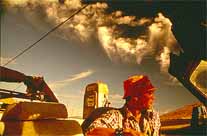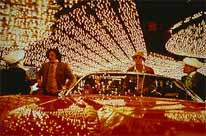 HST is the operative drug in this movie with a line of
Deppster and a Gilliam chaser. And so Hunter S.
Thompson's classic novel finally makes a splash
(more like a flood) on the silver screen. Hold onto
your seats and hold onto your heads. This is one
trip to L.V. you're not liable to ever forget.
HST is the operative drug in this movie with a line of
Deppster and a Gilliam chaser. And so Hunter S.
Thompson's classic novel finally makes a splash
(more like a flood) on the silver screen. Hold onto
your seats and hold onto your heads. This is one
trip to L.V. you're not liable to ever forget.
Warning: Don't do anything before seeing this
movie that might make you paranoid; unless that's
what you're into. Director Terry Gilliam is on the
loose again.
Fear and Loathing in Las Vegas
© RCV Film Distribution

|
The first message held up before our eyes reminds
us that "He who makes a beast of himself gets rid of
the pain of being a man. - Dr. Samuel Johnson,
1709-1784." It seems some things never change.
So, in that case, let's move a couple of centuries
forward: ZIP!
It's 1971 and journalist Raoul Duke (Johnny Depp)
and his manager/attorney/friend Dr. Gonzo (Benicio
Del Toro) are speeding down the road through the
desert in their red convertible with a suitcase full of
drugs and a state of mind which is almost as
incredible as the world they live in. Exaggerated?
Where were you when the lights went on? Now
you're in Bat Country and on your way to Hell.
Thompson actually took the journey that the novel is
based upon with his friend and associate Oscar Zeta
Acosta, lawyer and activist from Chicago. "As true
Gonzo Journalism, this doesn't work at all (and even
if it did, I couldn't possibly admit it. Only a goddamn
lunatic would write a thing like this and claim it was
true."
Las Vegas of 1971 simply doesn't exist anymore.
The new Disneyland-type city which has sprung up
since then in the middle of the desert has evolved in
accordance with a "fun for the whole family" ideal
(?). In `71 it was closer to fantasy neon and rampant
madness laced with a harsh reality. Then again, if
you're Terry Gilliam why would you make things
easy on yourself. Among the tasks necessary to
establish certain historical locations were recreating
the now missing Mint Hotel as well as previous
incarnations of the Desert Inn and Flamingo Hotel.
Added to these is the new design for the fantastic
Bazooka Circus Hotel and Casino (certainly the
place to stay if you're a freak) which is one spot
nobody is likely to ever forget. Actual existing
locations were also utilized, undoubtedly creating
even further confusion for contemporary casinos and
crowds. Go for it, Terry!
Fear and Loathing in Las Vegas
© RCV Film Distribution

|
Back to the Bazooko Circus, which production
designer Alex McDowell explains is, "a casino that
has a circus theme and the real inferno of the story.
On one level it has to be attractive, as any fun fair
would be, but there's seething ugliness beneath the
surface." There's always something to do. Guests
can choose among the various games on offer
including an M16 Shooting Gallery where ducks
wear Vietnamese hats, Shoot the Vital Organs which
uses hypodermic like darts, or the simple toss game
Knock the Kid's Teeth Out. The revolving carousel
bar turns wildly as acrobats soar insanely overhead,
flying each other as well as frightened wolverines.
Perhaps the pain and need and isolation and hope
are not as obvious as they might have been to drive
points home about connection to the environment
and society and, ultimately, influences upon a state
of being, but the image of these two men adrift in a
world of madness and paranoia is enough to suggest
all of it. Nixon (who was Time magazine's "Man of
the Year" in 1971) swims through the hotel room
from a TV screen in the same timescape where
protest marches about Vietnam are taking place
while elsewhere (not so very far away) lounge
lizards swill their drinks and Debbie Reynolds sings
to enraptured audiences. Vegas has become
another kind of world; one inside and reflecting the
outer world. Is there any way outa' here? Wherever
Thompson is busy turning the next page, Gilliam is
busy to inducing the next stage. Designer McDowell
explains that "Terry's instructions were to look to the
book if the script wasn't providing enough
information. We pored through Thompson's book
and (Richard) Steadman's illustrations, an then
came up with our own ideas based on the script and
whatever we were able to bring to it."
Johnny Depp, well on his way to establishing himself
as THE most extraordinary American actor produced
during this rapidly passing final quarter of the 20th
century, creates yet another memorable role for his
fans. Not a man to take his work lightly, he remarks
that, "Fear and Loathing has been screaming to be
made into a film since it was published 27 years ago.
The book came out of the beginning of the death of
the American Dream. But Hunter was still out there
searching for it, searching madly, hoping that the
Dream still existed, and all he found was madness in
every direction, and tragedy and greed. This book
represented a great quest for Hunter and a kind of
exorcism at the same time. Fear and Loathing is
about hope, it's about insanity, it's about trying to
find something out there to believe in." Not only did
Depp read everything written by Thompson that he
could get his hands on, but he spent a number of
months with him in order to study him for the role
and during that time wound up becoming his road
manager as well as a good friend. He admits that, "I
wanted to make Hunter proud because his story
deserved all attention and all focus. So I just tried to
make myself look as much like him as possible. I
shaved my head on top and just left a kind of
shorthaired chinchilla around the sides. Hunter's
ears are larger than mine, so I wore small devices to
make mine poke out a little more. And there's a
unique body language that Hunter has, and I could
feel myself clicking into it once we started."
Benecio Del Toro is also not to be outdone, as he
has proven from his past performances, and turns in
an equally impressive role as Dr. Gonzo. Anyone
who has seen him before will be well surprised to
note the 40 pounds he has gained to play Dr.
Gonzo, who, as created by Thompson, is both an
intimidating and overweight figure. Realizing this
aspect of the character should be dealt with
properly, Del Toro admits, "Every time I was bored I
ate." It's incredible to see the transformation he's
brought about.
Passing through the city of lights are star-studded
cameos performed by Gary Busey, Cameron Diaz,
Mark Harmon, Katherine Helmond, Penn Jillette,
Christina Ricci, Harry Dean Stanton, Lyle Lovett,
Flea (of the Red Hot Chili Peppers), Ellen Barkin,
and (are you ready?) Hunter S. Thompson (time
warp time).
The last scene in the movie suddenly takes a curve
in tone and shows the hard edge getting the upper
hand as the Waitress of the grimy North Star Cafe
(Ellen Barkin) caters to her two manic patrons. The
humor suddenly becomes subservient (similar to the
effects during the short and sparsely scattered
earlier newsreels and TV flashes earlier along the
way) to the start of a new raw post-70's reality, a
time and space when the Dream is dying. The
Waitress gets hit sharply by this stark confrontation
instead of the threatening meringue pie which never
flies in her direction. The guys leave the cafe and
head on down the road to the future that lies ahead.
Director Gilliam wrote the script with Tony Grisoni,
Tod Davies, and Alex Cox.
and his creative team includes producers Laila
Nabulsi (Nabulsi spent 15 years without giving up
the attempt to get the book onto the screen, for
which we thank you and love you, Laila), Patrick
Cassavetti, and Steve Nemeth, DP Nicola Pecorini,
production designer Alex McDowell, costume
designer Julie Weiss, and editor Lesly Walker. And
who deserves special compliments? As usual in a
film made by Gilliam, the answer is everybody.
What a piece of work.
 A DON'T MISS! A DON'T MISS!
 A MUST SEE. A MUST SEE.
A WHAT DID I
TAKE BEFORE I WALKED INTO THIS MOVIE?
© 1994-2006 The Green Hartnett
|
